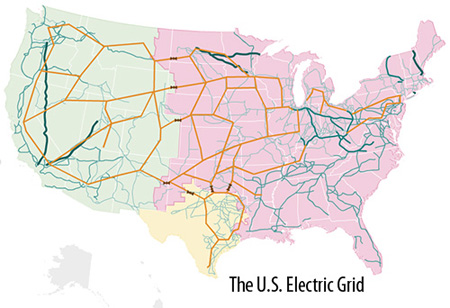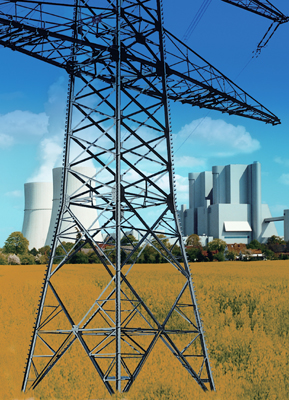Chapter 6 - Energy Sustainability
Part 3 - Electricity: Transmission, Distribution and Economics
Delivering Electricity to End Users
C. Transmission Lines and Grid Operations

The interlocking system of lines that relay electric power is called "the Grid". About 12% of all power lines are transmission lines, with the remaining portion (88%) being composed of distribution lines. The majority of these transmission lines are owned by regional utilities, which means that in order to move power across a service area, a marketer must pay "wheeling charges". There are companies that own only transmission assets, as well as investor-driven projects that target key bottlenecks. There are over 200,000 miles of high-voltage (230kW+) transmission lines in the US. FERC (Federal Energy Regulatory Commission) regulates shareholder-owned wholesale and interstate transmission (co-ops and fed/state utilities are 1/3 market).
High Voltage Direct Current (HVDC)
 Thomas Edison was a proponent of using direct current; however, at very low voltages there is significant energy loss due to relatively high current (P = VI; P = IR^2). He advocated a network of lots of small generating stations (an early form of distributed generation). George Westinghouse invented a system of AC that used transformers, which allowed more efficient transmission over longer distances. This system eventually prevailed. The invention of solid-state inverters in Sweden in the 1960s, which made it possible to transform current, encouraged the transmission of DC current. This development was significant because a DC line is less expensive over a long distance than an AC line, because it has fewer cables (2 vs 3 for AC). These cost savings offset the fact that the inverters are very expensive. Additionally, for a DC line, voltage is constant (vs the sine wave form for AC current), thus for a given power rating the line can be strung at a lower voltage, saving on costs for insulation. Conductors can also be closer together, reducing tower costs. DC systems do not have to be synchronized. DC systems are primarily used for long distance transmission of large volumes of energy, moderate distance underground or underwater transmission, or for grid stabilization.
Thomas Edison was a proponent of using direct current; however, at very low voltages there is significant energy loss due to relatively high current (P = VI; P = IR^2). He advocated a network of lots of small generating stations (an early form of distributed generation). George Westinghouse invented a system of AC that used transformers, which allowed more efficient transmission over longer distances. This system eventually prevailed. The invention of solid-state inverters in Sweden in the 1960s, which made it possible to transform current, encouraged the transmission of DC current. This development was significant because a DC line is less expensive over a long distance than an AC line, because it has fewer cables (2 vs 3 for AC). These cost savings offset the fact that the inverters are very expensive. Additionally, for a DC line, voltage is constant (vs the sine wave form for AC current), thus for a given power rating the line can be strung at a lower voltage, saving on costs for insulation. Conductors can also be closer together, reducing tower costs. DC systems do not have to be synchronized. DC systems are primarily used for long distance transmission of large volumes of energy, moderate distance underground or underwater transmission, or for grid stabilization.
Direct Current Generators Need Inverters to Convert DC to AC:
DC electricity must be converted to AC to work with the grid or AC equipment. Such things as photovoltaics (solar power), fuel cells, batteries, high-voltage transmission (also needs a rectifier), and AC to AC systems of different frequencies, such as direct-drive wind turbine, variable frequency motor drives, or induction heating all need some form of inverter in order to work with the grid.
Transmission Capacity Crunch
US use of transmission lines is growing, as a result of increased transactions between utilities, independent power producers, and growing demand for electricity. It is estimated that power outages and quality disturbances cost the economy $25 - $180 billion each year. However, from 1990 – 1999, demand increased by about 25%, while construction of transmission facilities decreased by about 30%. Investment has more than doubled since that time. From 2000 to 2007, $49 billion was invested in the nation's transmission system, with the expectation that investors would spend an additional $31 billion from 2008-2010. Predictions of the nation's future needs anticipate investing $300 billion in the transmission system between 2010 and 2030 to maintain reliable service. Transmission costs continue to increase, with a current cost of around $1.5 million/mile, and require a lead time of 10+ years.
Federal Reliability Oversight Committee
A rolling blackout through the Northeast US and Canada in 2003 prompted the US Congress to enact the Energy Policy Act of 2005, which created a new structure for establishing and enforcing mandatory electric reliability standards. Compliance with these standards is now mandatory and enforceable for the entire US electric power industry. The Act established the Federal Energy Regulatory Commission (FERC). This organization delegated some of its responsibilities to the North American Electric Reliability Corporation (NERC). NERC oversees the reliability standards applicable to all owners, operators, and users of the bulk transmission system. This includes Investor-owned utilities (IOUs), Public-owned utilities (POUs), direct access providers, wholesale generators, independent transmission owners, and independent system operators. NERC is a nonprofit organization that was originally formed in 1968 as a response to a substantial blackout in 1965. Its mission is to ensure the reliability of the bulk power system in North America. It has divided the continent into regions, with many Wester states belonging to the Western Electricity Coordinating Council (WECC). The Energy Act of 2005 created a new structure for enforcing reliability standards and in 2007 compliance with NERC reliability standards became mandatory. The operation of an electric power system requires coordination of the generation and consumption of power. This task is performed by Control Area Operators (CAOs). CAOs essentially allow the interconnected electric power systems and their components to interact efficiently and reliably. Transmission networks are the backbone of all electricity delivery. For example, San Francisco is particularly vulnerable to outages because it is a radial spoke on the greater network. Two power plants provide 570MW of local energy generation, but all of the energy entering the peninsula north of San Mateo must pass through a single substation. Peak load in San Francisco in 2008 was 950MW, and the predicted load growth by 2012 is 1,077MW.
Part 3 - Electricity: Transmission, Distribution and Economics
Delivering Electricity to End Users
A. Basic Structure of Electric Power System
B. Transformer Basics and Losses
C. Transmission Lines and Grid Operations
D. Environmental, Health and Safety Issues – T&D (NEXT)
E. System Losses Weigh Heavily on Electricity Systems in Developing Countries
F. A Revolution in the Electricity Sector?
G. Small-Scale Power: Distributed Generation
Summary: Smart-Grid: A Game-Changing Technology
Electricity Markets and the Future of Electricity?
(Adapted from the Energy Resources lecture materials of Jane Woodward, Consulting Associate Professor of Civil and Environmental Engineering and Karl Knapp, Lecturer of Civil and Environmental Engineering at Stanford University by Cheryl Chadwick/Gregory Möller)
(Image credits: NPR; Seimens AG)

